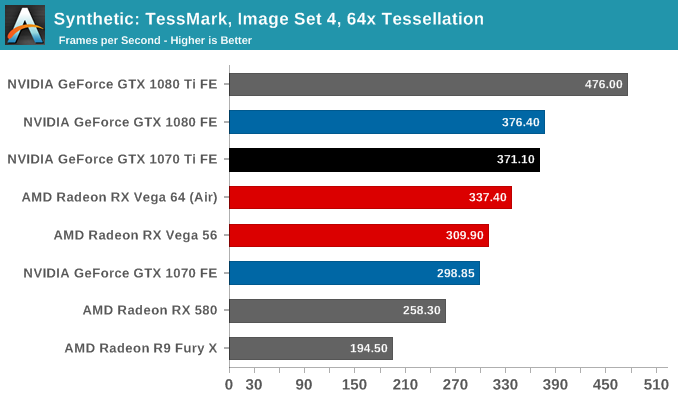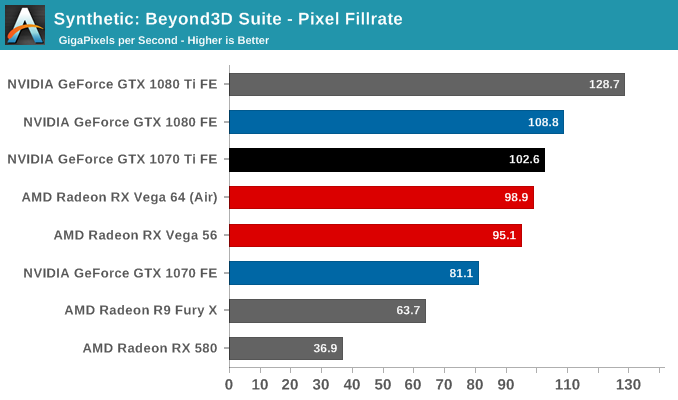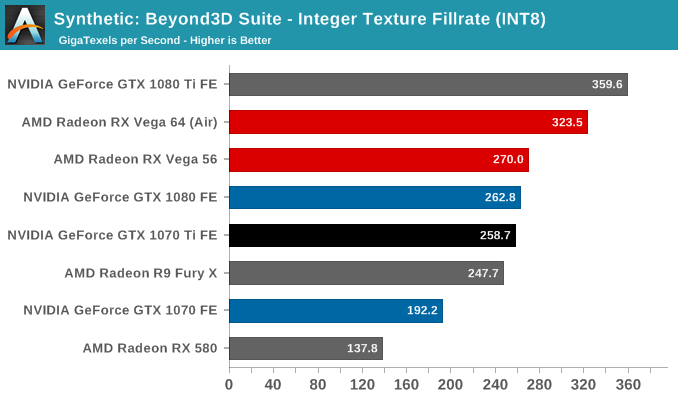The NVIDIA GeForce GTX 1070 Ti Founders Edition Review: GP104 Comes in Threes
by Nate Oh on November 2, 2017 9:00 AM EST- Posted in
- GPUs
- GeForce
- NVIDIA
- Pascal
- GTX 1070 Ti
Synthetics
Continuing onto our synthetic benchmarks, we should be able to see how the GTX 1070 Ti sits in between the GTX 1080 and 1070. These tests are more graphics focused than compute focused – especially the low-level tests – so it will be interesting to see how the GTX 1070 Ti compares to its fully-featured GP104 sibling, the GTX 1080, given how close they are so often in compute tests.

Starting off with tessellation performance, as NVIDIA's geometry performance is tied to the SMs, the GTX 1070 Ti benefits from having 3 more SMs enabled than the vanilla GTX 1070. This allows the new card to leapfrog both AMD Vega cards, coming in right behind the GTX 1080.

Switching gears, we have Futuremark's VRMark Orange benchmark. Essentially a synthetic gaming-type rendering workload with a focus on VR, this test pushes every part of a video card. Consequently, it also hits the weaker parts of the GTX 1070 Ti's configuration, particularly the lack of increased ROP throughput and memory bandwidth. As a result the GTX 1070 Ti still gains quite a bit over the GTX 1070, but it also trails the GTX 1080 by about 5%. Which, as it turns out, isn't too far removed from our general gaming benchmarks.
Finally, for looking at texel and pixel fillrate, we have the Beyond3D Test Suite. This test offers a slew of additional tests – many of which use behind the scenes or in our earlier architectural analysis – but for now we’ll stick to simple pixel and texel fillrates.

The pixel fillrate test is actually one of the more interesting results we have in today's review. While the GTX 1070 Ti doesn't get any more ROP resources on paper, pixel fillrates are a combination of both ROP (backend) and rasterizer (frontend) output. And in the case of NVIDIA's architecture, rasterization is not fully decoupled from the SMs; which is to say there's some scaling going on. And actually, this was more than I was expecting, with the GTX 1070 Ti coming very close to the GTX 1080 despite the memory bandwidth disadvantage. Not unlike tessellation performance, we see the new card leapfrog both AMD Vega cards here, pushing over 100 Gigapixels per second. In general pixel throughput is still going to be what best differentiates the GTX 1080 from the GTX 1070 Ti, but in this low-level test the two are closer than I would have expected.


Finally, for texture throughput, we're once again looking at a scenario tightly-coupled with the SM count. As a result the GTX 1070 Ti can deliver texture throughput rates very close to the GTX 1080.










78 Comments
View All Comments
BrokenCrayons - Thursday, November 2, 2017 - link
This review was a really good read. I also like that the game screenshots were dropped from it since they didn't exactly add much, but do eat a little of my data plan when I'm reading from a mobile device.As for the 1070 Ti, agreed its priced a bit too high. However, I think most of the current-gen GPUs are pushing the price envelope right now. Except maybe the 1030 of course which has a reasonable MSRP and doesn't require a dual slot cooler. That's really the only graphics card outside of an iGPU I'd seriously consider if I were in the market at the moment, but then again I'm not playing a lot of games on a PC because I have a console and a phone for that sort of thing.
Communism - Thursday, November 2, 2017 - link
Literally the same price as a 1070 non-Ti was a week ago.Those cards sold so well that retailers are still gouging them to this day.
Communism - Thursday, November 2, 2017 - link
And I should mention that the only reason that retail prices of 1070, Vega 56, and Vega 64 went down is due to the launch of 1070 Ti.timecop1818 - Thursday, November 2, 2017 - link
Still got that fuckin' DVI shit in 2017.DanNeely - Thursday, November 2, 2017 - link
Lack of a good way to run dual link DVI displays via HDMI/DP is probably keeping it around longer than originally intended. This includes both relatively old 2560x1600 displays that predate DP or HDMI 1.4 and thus could only do DL-DVI, and cheap 'Korean' 2560x1440 monitors from 2 or 3 years ago. The basic HDMI/DP-DVI adapters are single link and max out at 1920x1200. A few claim 2560x1600 by overclocking the data rate by 100% to stuff it down a single link worth of wires; this is mostly useless though since other than HDMI1.4 capable displays (which don't need this) virtually no DVI monitors can actually take a signal that fast. Active DP-DLDVI adapters can theoretically do it for $70-100, but they all came out buggy to one degree or another and sales were apparently too low to justify a new generation of hardware that fixed the issues.Nate Oh - Saturday, November 4, 2017 - link
This is actually precisely why I don't mind DVI too much, because I have and still use a 1-DVI-input-only Korean 1440p A- monitor from 3 years ago, overclocked to 96Hz. DVI probably needs to go away at some point soon, but maybe not too soon :)ddferrari - Friday, November 3, 2017 - link
So, that DVI port really ruins everything for ya? What are you, 14??There are tons of overclockable 1440p Korean monitors out there that only have one input- DVI. Adding a DVI port doesn't increase cost, slow down performance, or increase heat levels- so what's your imaginary problem again?
Notmyusualid - Sunday, November 5, 2017 - link
@ ddferrariWhat are you - ddriver incarnate?
I'm older than 14, and I wish the DVI port wasn't' there, as it is work to strip them off when I make my GPUs into single-slot water-cooled versions. Removing / modifying the bracket is one thing, but pulling out those DVI ports is another.
Silma - Thursday, November 2, 2017 - link
How can you compare the Vega 56 to the GTX 1070 when it's 7 dB noisier and consumes up to 78 watts more ?sach1137 - Thursday, November 2, 2017 - link
Because the MSRP's of both the cards are same. Vega 56 beats 1070 in almost all games.yes it consumes more power and noiser too. But for some people it doesnt matter it gives 10-15% more performance than 1070. When Overclocked you can extract more from Vega 56 too.